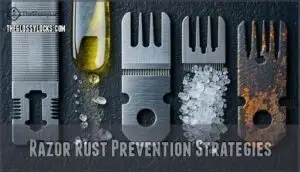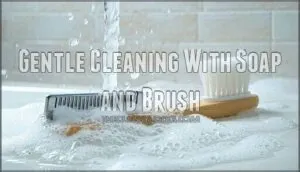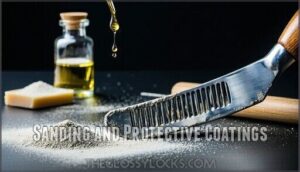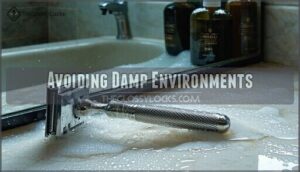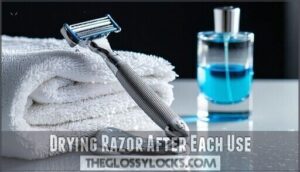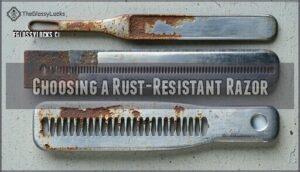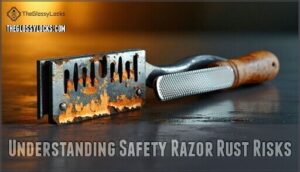This site is supported by our readers. We may earn a commission, at no cost to you, if you purchase through links.
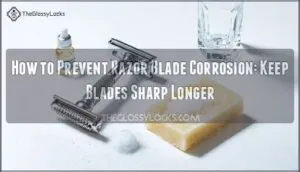
After each shave, rinse thoroughly with hot water and dry completely with a towel. Store it in a dry location with silica gel packets if you live somewhere humid.
You can also apply a thin layer of mineral oil to the blade after drying. Clean soap residue regularly since it traps moisture against the metal.
For safety razors, disassemble parts occasionally for thorough cleaning. These simple steps dramatically extend blade life – some users report getting months from a single blade instead of weeks when moisture takes its toll.
Table Of Contents
- Key Takeaways
- Understanding Stainless Steel Corrosion
- Razor Rust Prevention Strategies
- Cleaning and Removing Razor Rust
- Proper Razor Storage and Maintenance
- Choosing a Rust-Resistant Razor
- Understanding Safety Razor Rust Risks
- Frequently Asked Questions (FAQs)
- How do you keep razor blades from rusting?
- How do you keep razor blades sharp?
- How do you care for a razor?
- Why do razor blades rust?
- What can I use to lubricate my razor blade?
- What is the best rust inhibitor for razor blades?
- How to preserve a razor blade?
- How to extend the life of a razor blade?
- How to keep your razor blade from rusting?
- Why do razor blades rust so quickly?
- Conclusion
Key Takeaways
- Dry your razor completely after each use – Rinse with hot water, pat dry with a towel, and store in a low-humidity area away from your bathroom to prevent moisture buildup
- Apply mineral oil as a protective barrier – A thin layer after drying creates a moisture-resistant coating that dramatically extends blade life from weeks to months
- Use rubbing alcohol for thorough water removal – Dip your razor in isopropyl alcohol after shaving to displace water and speed evaporation before storage
- Choose high-grade stainless steel razors – Look for blades with 13%+ chromium content and protective coatings from reputable manufacturers to resist corrosion from the start
Understanding Stainless Steel Corrosion
You might think all stainless steel blades resist rust equally, but the chromium content and grade make a huge difference in how well your razor fights corrosion.
The presence of sulfur compounds from soaps and hard water can actually speed up rust formation on even high-quality stainless steel blades, which is a critical factor to consider when evaluating the corrosion resistance of your razor.
Even premium stainless steel surrenders to sulfur’s corrosive assault from everyday soaps and minerals.
Chromium Content and Grades
Understanding chromium percentage in steel composition is vital for corrosion resistance.
Razor blades need at least 10.5% chromium content to qualify as stainless steel, with higher percentages offering superior protection against rust and extending blade lifespan. 6Cr13 steel’s martensitic structure guarantees a fine edge.
- 3Cr13 steel contains 12.5-14.5% chromium for solid corrosion resistance
- 6Cr13 grade boosts chromium to 15.5% for premium blade material performance
- 316L stainless steel delivers exceptional rust protection with refined chromium alloy elements
- Carbon steel blades lack chromium entirely, making them prone to rapid razor blade corrosion
Impact of Sulfur on Rust Formation
While chromium protects your razor, sulfur compounds work against you.
Even small amounts of sulfur in steel composition create weak spots where razor rust starts.
These sulfur sources include manufacturing impurities and environmental factors like acid rain.
High purity alloys still show good general corrosion resistance, despite the presence of sulfur.
| Sulfur Impact | Effect on Blades |
|---|---|
| Low sulfur content | Better corrosion prevention |
| High sulfur steel | Faster corrosion rate |
| Environmental sulfur | Accelerated metal corrosion |
Humidity makes sulfur’s effects worse, speeding up razor blade corrosion substantially.
Factors Affecting Rust Speed
Several factors determine how fast your razor develops rust:
- Humidity Levels: High moisture accelerates blade corrosion rapidly
- Metal Dissimilarity: Different metals create galvanic corrosion when they touch
- Water Quality: Hard water with minerals speeds up metal corrosion
- Blade Coatings: Protective layers slow corrosion prevention substantially
- Storage Practices: Proper drying prevents razor rust formation completely
Temperature and contact with dissimilar metals also affect corrosion speed dramatically.
Razor Rust Prevention Strategies
With proper care, you’ll keep your razor rust-free and sharp longer.
Oiling blades with mineral oil creates a protective barrier against moisture. Alcohol submersion in isopropyl alcohol after each use removes water completely.
Store blades with proper blade orientation – edge up prevents water pooling. Use desiccant packets in storage containers to control humidity.
Make certain good air ventilation around stored razors for complete drying.
Cleaning and Removing Razor Rust
If you’ve discovered rust on your razor, don’t panic – it’s often easier to clean than you think.
You can tackle light rust with gentle soap and a soft brush, or use vinegar and baking soda for stubborn spots.
Gentle Cleaning With Soap and Brush
Light rust-stains vanish when you tackle them with gentle soap scrubbing. Choose castile soap and an old toothbrush for effective razor blade cleaning without damaging delicate edges.
Brush Type matters—soft bristles work best for Gentle Scrubbing while removing shaving cream residue.
Clean weekly to maintain proper razor hygiene habits and guarantee thorough Residue Removal from all surfaces.
For enhanced hygiene, consider soaking in rubbing alcohol to disinfect the blade, ensuring proper razor hygiene and thorough cleaning.
Aggressive Approach With Vinegar and Baking Soda
When should you bring out the heavy artillery?
White vinegar’s acidity dissolves rust effectively, while baking soda’s abrasive reaction scrubs away stubborn corrosion without damaging your razor blade’s surface.
This dynamic duo tackles material compatibility concerns since both ingredients are gentle enough for most steel types.
After scrubbing, thorough residue removal prevents future razor blade corrosion prevention issues during your daily shaving routine with the help of white vinegar.
Sanding and Protective Coatings
When gentle cleaning fails, fine-grit sandpaper tackles stubborn rust effectively.
Work along the blade’s length using minimal pressure to preserve sharpness. After sanding, apply mineral oil or consider advanced titanium nitride coatings for superior corrosion protection.
These protective coating materials create lasting barriers against moisture, extending blade longevity substantially. You can find various mineral oil products to help with this.
Proper Razor Storage and Maintenance
Storing your razor properly prevents corrosion that makes blades dull faster than actual use. You’ll extend blade life substantially by controlling moisture and choosing the right storage location.
Avoiding Damp Environments
Keep your razor away from the shower’s steamy embrace – that humid environment accelerates rust formation faster than you’d think.
Poor bathroom ventilation and shower proximity create perfect conditions for corrosion.
Instead, choose countertop storage with good air circulation, or better yet, store your razor in a bedroom drawer.
To further protect your razor, consider sterilizing with alcohol after each use.
Humidity control prevents razor rust effectively, and is a key part of effective razor care.
Drying Razor After Each Use
Air drying your razor properly prevents moisture traps that cause rust.
After shaving, shake off excess water and towel dry each component thoroughly.
Consider an alcohol rinse with isopropyl alcohol—it displaces water and evaporates quickly.
Store your dry razor blade upright to promote airflow around the blade angle.
These razor drying techniques substantially extend blade life.
Dedicated Storage Solutions
Dedicated storage solutions protect your razor from moisture better than any bathroom counter.
Sealed containers with desiccant packs create perfect dry storage environments, while silicone sleeves offer portable protection.
Consider dry cabinets for serious collectors or custom solutions like magnetic strips away from humid areas.
You can even find a razor holder online for convenient storage.
These razor blade storage methods prevent razor blade corrosion and help dehumidify bathroom effects on your blades.
Choosing a Rust-Resistant Razor
When you’re selecting a new razor, the material and construction make all the difference in fighting corrosion.
Look for razors made from high-grade stainless steel with protective coatings, and choose reputable manufacturers who prioritize quality over cutting costs, which is crucial in ensuring the quality of the razor.
Stainless Steel Grade Selection
Not all stainless steel performs equally against corrosion – you’ll want specific grades for maximum rust protection.
The chromium percentage directly determines your blade’s longevity, while martensitic alloys balance sharpness with corrosion prevention methods.
Here’s what matters most:
- Chromium percentage above 13% – Creates self-healing protective layers
- Martensitic alloys like 440C – Harder than austenitic steels for sharp edges
- Low molybdenum addition – Prevents pitting in humid bathrooms
- Avoid ferritic grades – They’re softer and rust faster than quality razor materials
Protective Coatings and Treatments
High-quality blade coatings transform ordinary razors into rust-fighting machines.
Advanced coatings like chromium and black oxide create protective barriers against moisture.
PTFE and silicone layers add slick, non-stick surfaces that resist corrosion inhibitors.
Applying mineral oil creates an additional shield.
For serious protection, cathodic protection uses electrical current to prevent rust formation entirely.
Manufacturer Reputation and Quality
Beyond protective coatings, manufacturer reputation matters when selecting quality razor blades.
Smart shoppers research brands known for:
- Brand longevity with decades of blade manufacturing expertise
- Material sourcing that prioritizes corrosion resistant blades from premium steel
- Warranty policies backing their blade durability claims with real guarantees
User reviews reveal coating consistency issues before you buy.
Established manufacturers invest in better blade coatings.
Understanding Safety Razor Rust Risks
Many people worry about tetanus from rusty razors, but rust itself doesn’t cause tetanus—bacteria do, and they’re rarely found on modern bathroom razors.
While a rusty razor won’t give you lockjaw, it will give you nicks, cuts, and a terrible shave that’s harder to fix than it’s to prevent.
Dispelling Tetanus Myths
You’ve probably heard scare stories about tetanus from rusty razors, but don’t panic.
Tetanus transmission requires deep puncture wounds, not surface contact with rust. If you’re vaccinated (most adults are), your tetanus immunity protects you.
Even without vaccination, tetanus symptoms develop slowly, and modern tetanus treatment is highly effective.
While proper razor blade care and razor maintenance tips prevent razor rust and extend razor life, tetanus prevention shouldn’t drive your razor corrosion prevention efforts. Focus on keeping blades sharp, not avoiding an unlikely infection, and prioritize proper razor maintenance.
Thorough Rust Removal Importance
When tackling rust removal, you’re protecting more than just appearance. Surface rust spreads quickly, compromising blade integrity and shaving quality. Deep corrosion creates rough edges that cause skin irritation and dull performance.
Regular maintenance helps extend razor blade lifespan.
Effective rust removal requires:
- Gentle cleaning methods for light surface rust
- Chemical treatments like vinegar for stubborn corrosion
- Proper metal preservation after cleaning
- Complete drying to prevent immediate re-rusting
Preventing Rust is Easier Than Removing
Early prevention beats rust removal every time – simple habits like razor blade drying after each shave and proper razor blade storage save you money and time.
Stop razor corrosion before it starts with blade rust prevention techniques that guarantee blade longevity.
Razor blade corrosion prevention costs pennies compared to constantly buying replacements.
Frequently Asked Questions (FAQs)
How do you keep razor blades from rusting?
Keep razor blades dry after use by rinsing, patting with a towel, and storing in low-humidity areas. Apply mineral oil for protection, or dunk in rubbing alcohol before air-drying completely.
How do you keep razor blades sharp?
Dry your razor completely after each use and store it in a low-humidity environment. Corrosion, not cutting, dulls blades fastest, so preventing moisture contact keeps edges sharp longer.
How do you care for a razor?
Rinse razor components thoroughly, then dunk in rubbing alcohol before air drying completely. Store in low-humidity areas away from bathrooms. Apply thin mineral oil coating for extended protection.
Why do razor blades rust?
Razor blades rust because water and oxygen create a chemical reaction that corrodes the metal.
Bathroom humidity, trapped moisture between blade edges, and dissimilar metals in handles accelerate this oxidation process, dulling your blade faster than actual cutting.
What can I use to lubricate my razor blade?
You can protect your blade with mineral oil, baby oil, or food-grade oils that create a moisture barrier.
Apply a thin layer after cleaning and drying your razor completely for best results.
What is the best rust inhibitor for razor blades?
Mineral oil works best as a rust inhibitor for your blades.
It creates a protective barrier that blocks oxygen and water, the two culprits behind corrosion.
Apply it after cleaning and drying completely.
How to preserve a razor blade?
Keep your blade dry after each shave by rinsing thoroughly, patting with a towel, and storing in a moisture-free environment. Apply mineral oil for protection.
How to extend the life of a razor blade?
That dull blade you’re tossing isn’t worn out—it’s corroded.
After each shave, rinse thoroughly, pat dry with a towel, then store in a cool, dry place away from humid bathrooms.
How to keep your razor blade from rusting?
Rinse thoroughly after each shave, then dip your razor in rubbing alcohol and air-dry completely. Store it in a dry location away from humid bathrooms to prevent rust formation.
Why do razor blades rust so quickly?
Here’s your bathroom’s dirty secret: moisture turns your razor into a tiny battery.
When water hits those dissimilar metals in your razor, it creates galvanic corrosion that eats away your blade’s edge faster than you’d expect.
Conclusion
Picture a gleaming razor blade slicing effortlessly through whiskers, its edge pristine and sharp as the day you bought it.
Learning how to prevent razor blade corrosion transforms this vision into reality.
You’ve discovered that proper storage, thorough drying, and regular maintenance aren’t just suggestions—they’re your blade’s lifeline.
With these strategies, you’ll save money while enjoying consistently smooth shaves, and remember, preventing rust beats removing it every time.
- https://www.youtube.com/watch?v=ZGAtVZJknZs
- https://www.reddit.com/r/shaving/comments/1944i34/how_do_you_keep_your_razors_from_rusting_wearing/
- https://www.xiruiblade.com/blog/what-are-safety-razor-blades-coated-with
- https://itsjustsharp.com/blogs/the-sharp-blog/understanding-blade-coatings-and-their-benefits
- https://www.elegantgbarbershop.com/12-quick-tips-for-maintaining-your-razor-and-shaving-gear/

